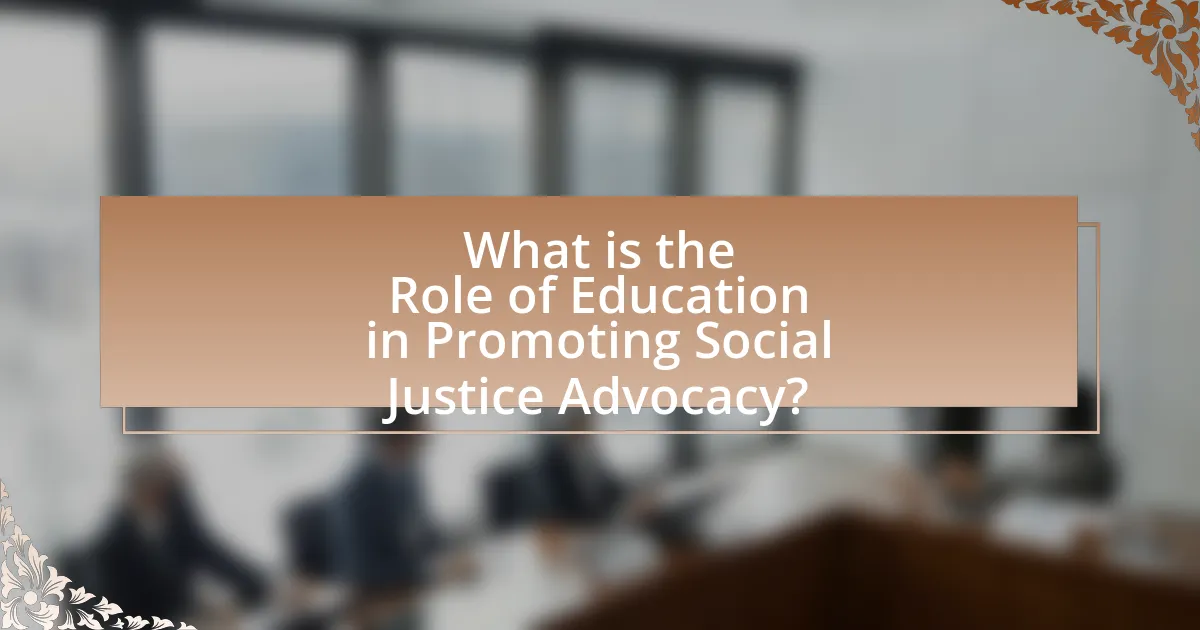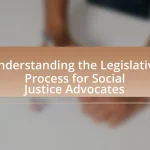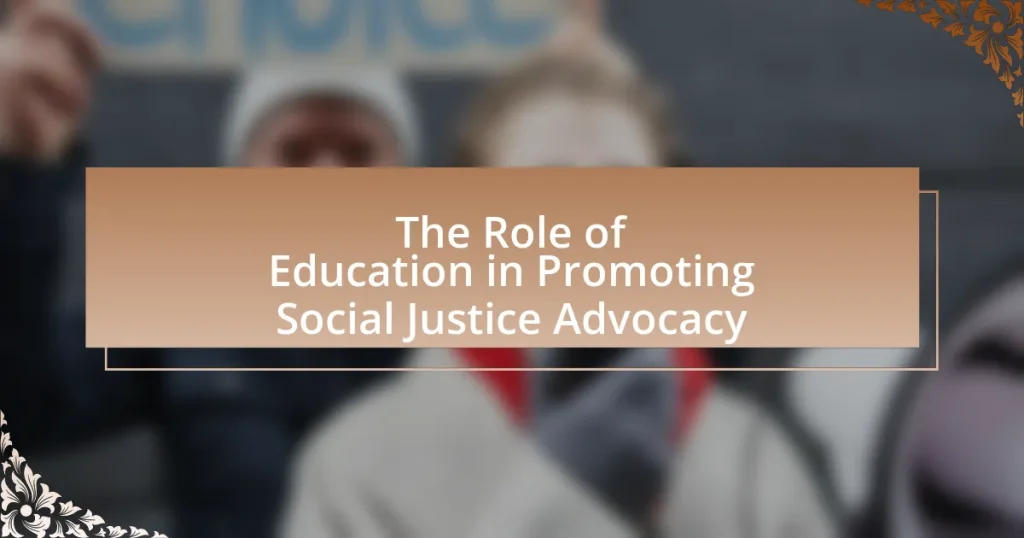The article examines the critical role of education in promoting social justice advocacy, highlighting how educational curricula can equip individuals with the knowledge and skills necessary to understand and challenge systemic inequalities. It discusses key educational principles such as equity, inclusivity, and critical pedagogy that support social justice, as well as the influence of educational institutions on social justice movements. The article also addresses the challenges faced in implementing social justice education, including systemic inequities and resistance to change, while offering best practices for educators to create inclusive classrooms and engage in community partnerships. Overall, it emphasizes the transformative power of education in fostering civic engagement and empowering students to advocate for social justice.

What is the Role of Education in Promoting Social Justice Advocacy?
Education plays a crucial role in promoting social justice advocacy by equipping individuals with the knowledge and critical thinking skills necessary to understand and challenge systemic inequalities. Through curricula that emphasize social justice issues, students learn about historical injustices, the importance of equity, and the mechanisms of advocacy. Research indicates that educational programs focused on social justice can lead to increased civic engagement; for instance, a study by the American Educational Research Association found that students exposed to social justice education are more likely to participate in community activism and advocacy efforts. This demonstrates that education not only informs but also empowers individuals to take action against social injustices.
How does education contribute to social justice advocacy?
Education contributes to social justice advocacy by equipping individuals with critical thinking skills, awareness of social inequalities, and the ability to engage in informed activism. Through curricula that emphasize social issues, students learn about systemic injustices, such as racism, sexism, and economic disparity, which fosters a sense of responsibility to advocate for change. Research indicates that educational programs focused on social justice increase students’ civic engagement; for example, a study by the American Educational Research Association found that students exposed to social justice education are more likely to participate in community service and advocacy efforts. This connection between education and advocacy highlights the transformative power of learning in promoting equity and justice in society.
What are the key educational principles that support social justice?
The key educational principles that support social justice include equity, inclusivity, critical pedagogy, and empowerment. Equity ensures that all students have access to the same educational opportunities, regardless of their background, which is essential for addressing systemic inequalities. Inclusivity promotes a learning environment that respects and values diverse perspectives, fostering a sense of belonging among all students. Critical pedagogy encourages learners to question and challenge societal norms and injustices, facilitating critical thinking and social awareness. Empowerment focuses on equipping students with the skills and knowledge necessary to advocate for themselves and their communities, thereby promoting active participation in social change. These principles collectively contribute to a more just and equitable educational landscape.
How do educational institutions influence social justice movements?
Educational institutions influence social justice movements by serving as platforms for critical discourse, activism, and community engagement. They provide students with the knowledge and skills necessary to understand social inequalities and advocate for change. For instance, universities often host workshops, lectures, and events that raise awareness about issues such as racial injustice, gender equality, and environmental sustainability. Research indicates that students involved in campus activism are more likely to engage in civic activities post-graduation, demonstrating the long-term impact of educational settings on social justice engagement. Additionally, institutions can shape public policy by conducting research that informs social justice initiatives, as seen in studies published by organizations like the American Educational Research Association, which highlight the role of education in addressing systemic inequalities.
Why is social justice advocacy important in education?
Social justice advocacy is important in education because it promotes equity, inclusivity, and the empowerment of marginalized groups. By addressing systemic inequalities, social justice advocacy ensures that all students have access to quality education and resources, which is essential for fostering a fair society. Research indicates that schools implementing social justice curricula see improved student engagement and academic performance, as these programs encourage critical thinking and awareness of social issues. For instance, a study by the American Educational Research Association found that students exposed to social justice education are more likely to develop a sense of agency and responsibility towards their communities.
What impact does social justice advocacy have on students?
Social justice advocacy positively impacts students by enhancing their critical thinking skills and fostering a sense of civic responsibility. Engaging in social justice initiatives encourages students to analyze societal issues, understand diverse perspectives, and develop empathy towards marginalized communities. Research indicates that students involved in social justice advocacy demonstrate increased academic engagement and improved social skills, as evidenced by a study published in the Journal of Educational Psychology, which found that participation in advocacy programs correlates with higher levels of motivation and academic achievement.
How does social justice advocacy shape educational policies?
Social justice advocacy shapes educational policies by influencing the development and implementation of equitable practices that address systemic inequalities. Advocacy efforts often highlight disparities in access to resources, representation, and opportunities within educational systems, prompting policymakers to adopt reforms aimed at inclusivity. For instance, initiatives such as the Every Student Succeeds Act (ESSA) in the United States emerged partly due to advocacy for equitable education, emphasizing the need for accountability in addressing achievement gaps among marginalized groups. This demonstrates how social justice advocacy directly impacts legislative frameworks, leading to policies that prioritize fairness and equal opportunity in education.
What challenges does education face in promoting social justice advocacy?
Education faces significant challenges in promoting social justice advocacy, primarily due to systemic inequalities, lack of resources, and resistance to change. Systemic inequalities manifest in disparities in funding, access to quality education, and representation within curricula, which hinder equitable advocacy efforts. For instance, schools in low-income areas often receive less funding, resulting in fewer resources for teaching social justice topics. Additionally, educators may lack training or support to effectively address social justice issues, limiting their ability to foster critical discussions. Resistance to change can stem from political and cultural factors, where some stakeholders may oppose the inclusion of social justice themes in education, fearing it may challenge existing power structures. These challenges collectively impede the ability of educational institutions to serve as effective platforms for social justice advocacy.
What barriers exist within educational systems that hinder social justice?
Barriers within educational systems that hinder social justice include systemic inequities, inadequate funding, and biased curricula. Systemic inequities manifest in the form of disparities in resources and opportunities based on socioeconomic status, race, and geographic location, which can lead to unequal educational outcomes. Inadequate funding often results in overcrowded classrooms, lack of access to technology, and insufficient support services, disproportionately affecting marginalized communities. Additionally, biased curricula that fail to represent diverse perspectives can perpetuate stereotypes and limit students’ understanding of social justice issues. Research indicates that schools serving low-income students receive significantly less funding than those serving affluent populations, exacerbating these barriers.
How can educators overcome these challenges?
Educators can overcome challenges in promoting social justice advocacy by implementing inclusive curricula that reflect diverse perspectives and experiences. This approach fosters a learning environment where all students feel represented and valued, which is essential for effective engagement in social justice issues. Research indicates that inclusive education improves student outcomes and promotes critical thinking, as evidenced by a study published in the “Journal of Educational Psychology,” which found that students exposed to diverse viewpoints are more likely to develop empathy and social responsibility. Additionally, educators can engage in professional development focused on culturally responsive teaching strategies, enabling them to address biases and create equitable learning opportunities.
How can education systems effectively promote social justice advocacy?
Education systems can effectively promote social justice advocacy by integrating social justice principles into the curriculum and fostering an inclusive environment. This approach ensures that students learn about equity, diversity, and the importance of advocacy from an early age. Research indicates that when curricula include topics such as systemic inequality and human rights, students are more likely to engage in social justice initiatives. For example, a study by the National Education Association found that schools implementing social justice education saw a 30% increase in student participation in community service and advocacy projects. By training educators to facilitate discussions on social justice and providing resources for student-led initiatives, education systems can empower students to become active advocates for change.
What teaching methods are most effective for social justice education?
Collaborative learning and critical pedagogy are the most effective teaching methods for social justice education. Collaborative learning encourages students to work together, fostering a sense of community and shared responsibility, which is essential for understanding social justice issues. Critical pedagogy, as advocated by Paulo Freire, emphasizes dialogue and reflection, enabling students to question societal norms and engage in transformative action. Research shows that these methods enhance students’ critical thinking skills and promote active citizenship, as evidenced by studies such as “Teaching for Social Justice: A Critical Pedagogy Approach” by Adam S. E. McGowan, which highlights the positive impact of these methods on student engagement and awareness of social issues.
How can curricula be designed to include social justice themes?
Curricula can be designed to include social justice themes by integrating diverse perspectives, critical thinking, and real-world applications into the educational framework. This approach involves incorporating materials that reflect the histories and contributions of marginalized groups, fostering discussions around equity, and encouraging students to engage in community-based projects that address social issues. Research indicates that curricula that emphasize social justice not only enhance students’ understanding of societal structures but also promote civic engagement and empathy, as evidenced by studies showing improved student outcomes in schools that prioritize these themes.
What role do community partnerships play in education and social justice advocacy?
Community partnerships are essential in education and social justice advocacy as they foster collaboration between schools, families, and local organizations to address systemic inequalities. These partnerships enhance educational resources, provide support services, and create inclusive environments that empower marginalized communities. For instance, research by the National Education Association highlights that schools engaged in community partnerships see improved student outcomes and increased community engagement, which are critical for advancing social justice initiatives. By leveraging local knowledge and resources, community partnerships help to create equitable educational opportunities and advocate for policies that promote social justice.
How can schools collaborate with community organizations for social justice?
Schools can collaborate with community organizations for social justice by establishing partnerships that focus on shared goals, such as equity and inclusion. These collaborations can involve joint programs, resource sharing, and community engagement initiatives that address local social issues. For instance, schools can work with organizations like local nonprofits to create mentorship programs that support underrepresented students, thereby fostering a more equitable educational environment. Research indicates that such partnerships enhance student learning and community cohesion, as seen in studies like “The Impact of Community Engagement on Student Success” by the National Education Association, which highlights the positive outcomes of school-community collaborations in promoting social justice.
What are the benefits of community involvement in educational advocacy?
Community involvement in educational advocacy enhances student outcomes and fosters a supportive learning environment. Engaging families and local organizations leads to increased resources, such as funding and volunteer support, which directly benefit schools. Research indicates that schools with strong community ties experience higher student achievement and lower dropout rates, as evidenced by a study from the National Education Association, which found that community engagement can improve academic performance by up to 20%. Additionally, community involvement promotes a sense of ownership and accountability among stakeholders, leading to more effective educational policies that reflect the needs of the community.
What are best practices for educators in promoting social justice advocacy?
Best practices for educators in promoting social justice advocacy include integrating social justice themes into the curriculum, fostering an inclusive classroom environment, and encouraging critical thinking. Educators should design lessons that reflect diverse perspectives and address systemic inequalities, which can enhance students’ understanding of social justice issues. Research indicates that when educators incorporate real-world social issues into their teaching, students are more likely to engage in advocacy and activism (Ladson-Billings, 1994). Additionally, creating a safe space for open dialogue allows students to express their views and experiences, further promoting awareness and empathy. By modeling advocacy behaviors and collaborating with community organizations, educators can empower students to take action on social justice issues.
How can teachers create inclusive classrooms that support social justice?
Teachers can create inclusive classrooms that support social justice by implementing culturally responsive teaching practices. This approach involves recognizing and valuing the diverse backgrounds of students, which fosters an environment where all voices are heard and respected. Research indicates that culturally responsive teaching improves student engagement and academic success, particularly for marginalized groups (Gay, 2010). By integrating diverse perspectives into the curriculum and encouraging critical discussions about social issues, teachers can empower students to understand and challenge systemic inequalities. Additionally, establishing clear guidelines for respectful communication and collaboration among students promotes a sense of belonging and community, essential for an inclusive classroom.
What resources are available for educators to enhance social justice advocacy?
Educators can enhance social justice advocacy through various resources, including professional development programs, curriculum guides, and online platforms. Professional development programs, such as those offered by the Teaching Tolerance initiative, provide educators with training on inclusive practices and social justice issues. Curriculum guides, like the “Social Justice Standards” developed by the Teaching Tolerance project, offer frameworks for integrating social justice into classroom instruction. Online platforms, such as Edutopia and the Zinn Education Project, provide articles, lesson plans, and teaching resources focused on social justice themes. These resources are validated by their widespread use in educational settings and their alignment with current educational standards promoting equity and inclusion.










